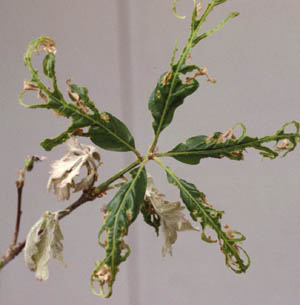Leaf Tatters | |
|---|---|
| May 16, 2006 | |
|
I have described this problem in the past, but with our new format including pictures online, we can show what we have been seeing the last several years. Leaf tatters is the new name for what we have called oak tatters. The problem appears on oaks and hackberry, so to call it “oak tatters” is too limiting. This condition appears each spring in Illinois. Horticulture research specialist Jim Appleby reports that leaf tatters has appeared in southern Illinois already this season. Leaves of trees with leaf tatters appear to have been eaten by something that avoided the veins. Only the veins and a bit of the blade around the veins remain intact. A picture of a clinic sample with tatters follows (image 060505).  We have seen this problem on white oaks for at least 15 years in Illinois. It has been reported in other states as well, including Iowa, Indiana, Ohio, Michigan, Wisconsin, Minnesota, and Missouri. The problem appears on hackberry as well. We have seen this problem on white oaks for at least 15 years in Illinois. It has been reported in other states as well, including Iowa, Indiana, Ohio, Michigan, Wisconsin, Minnesota, and Missouri. The problem appears on hackberry as well. I enjoy writing about problems that are shown to be free of diseases. No disease problem has been implicated in leaf tatters. Likewise insects are not the cause of oak leaf tatters. For many years, suspect causes included environmental stress as leaves emerge, cold damage, and herbicide drift. Three researchers at the University of Illinois have studied the problem and have research that proves that drift of chloroacetamide herbicides from applications onto corn and soybean fields is a cause of the leaf tatters syndrome. The researchers are Jayesh Samtani (lead researcher), John Masiunas, and Jim Appleby. An article describing their work can be found in the Plant Health Progress On-line Journal, February 2005, at http://www.plantmanagementnetwork.org/sub/php/brief/2005/tatters. The original study was in 2004. It was repeated in 2005 with the same results. Plans to repeat some of the study in 2006 are underway. White oak is the common oak species affected. Hackberry also shows leaf tatters each spring. I spoke with Dr. Appleby. He said that the white oak group of trees is usually affected, but injury on red oaks occurs occasionally as well. Researchers have reproduced the injury on red oaks. Red oaks leaf out sooner than oaks in the white oak group. It is likely that red oaks are less susceptible because they are further along in development when chemicals are applied. Hackberries tend to keep leafing out over a long period. Many of the trees with oak tatters are affected early in the season but produce normal leaves later in the season. This is probably due to the fact that chemical applications of these products do not occur later. There has been some concern that a tree repeatedly attacked by oak tatters might decline and even die. No evidence exists to confirm this theory, but the question merits investigation. You may help your trees by following good horticultural practices to promote tree health, especially watering in periods of drought. If you have seen leaf tatters in your area, drop me a note at npataky@uiuc.edu. I would like to know when tatters appeared, the county, and the host. I will pass along this information to the researchers listed above. |